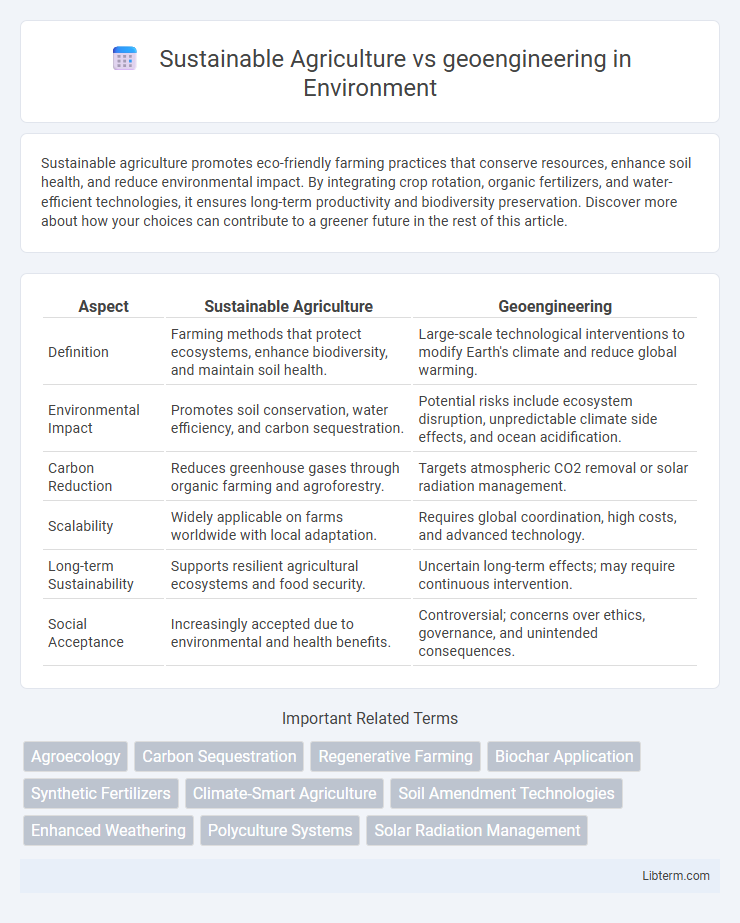Sustainable agriculture promotes eco-friendly farming practices that conserve resources, enhance soil health, and reduce environmental impact. By integrating crop rotation, organic fertilizers, and water-efficient technologies, it ensures long-term productivity and biodiversity preservation. Discover more about how your choices can contribute to a greener future in the rest of this article.
Table of Comparison
| Aspect | Sustainable Agriculture | Geoengineering |
|---|---|---|
| Definition | Farming methods that protect ecosystems, enhance biodiversity, and maintain soil health. | Large-scale technological interventions to modify Earth's climate and reduce global warming. |
| Environmental Impact | Promotes soil conservation, water efficiency, and carbon sequestration. | Potential risks include ecosystem disruption, unpredictable climate side effects, and ocean acidification. |
| Carbon Reduction | Reduces greenhouse gases through organic farming and agroforestry. | Targets atmospheric CO2 removal or solar radiation management. |
| Scalability | Widely applicable on farms worldwide with local adaptation. | Requires global coordination, high costs, and advanced technology. |
| Long-term Sustainability | Supports resilient agricultural ecosystems and food security. | Uncertain long-term effects; may require continuous intervention. |
| Social Acceptance | Increasingly accepted due to environmental and health benefits. | Controversial; concerns over ethics, governance, and unintended consequences. |
Understanding Sustainable Agriculture: Principles and Practices
Sustainable agriculture emphasizes soil health, biodiversity, and water conservation to enhance ecosystem resilience and long-term food security. It integrates crop rotation, organic farming methods, and agroforestry to reduce environmental impact and promote regenerative land use. In contrast to geoengineering, sustainable agriculture focuses on enhancing natural processes rather than large-scale technological interventions to address climate challenges.
Geoengineering Explained: Scope and Methods
Geoengineering encompasses large-scale intervention techniques aimed at mitigating climate change, primarily through methods such as solar radiation management and carbon dioxide removal. Techniques include stratospheric aerosol injection, ocean fertilization, and direct air capture, each varying in scalability and potential environmental risks. Unlike sustainable agriculture, which enhances ecosystem resilience through soil health and biodiversity, geoengineering targets atmospheric processes with uncertain long-term outcomes.
Environmental Impact: Comparing Both Approaches
Sustainable agriculture enhances ecosystem resilience by promoting biodiversity, improving soil health, and reducing greenhouse gas emissions through natural processes such as crop rotation and organic farming. Geoengineering methods, including solar radiation management and carbon capture, aim to mitigate climate change rapidly but carry risks of unintended environmental consequences like ocean acidification and disruption of weather patterns. Evaluating environmental impacts reveals sustainable agriculture offers long-term ecological benefits with lower risks, while geoengineering presents uncertain outcomes with possible large-scale ecological disruptions.
Resource Efficiency and Land Use
Sustainable agriculture enhances resource efficiency by optimizing water use, soil health, and biodiversity, minimizing dependency on chemical inputs while promoting long-term land productivity. Geoengineering approaches, such as carbon capture and solar radiation management, often require significant land allocation and energy resources, potentially competing with agricultural activities and disrupting ecosystems. Prioritizing sustainable farming practices supports efficient land use by maintaining soil integrity and reducing environmental impacts, whereas geoengineering risks unintended consequences on land availability and resource distribution.
Climate Change Mitigation: Role of Agriculture vs Geoengineering
Sustainable agriculture contributes to climate change mitigation by enhancing soil carbon sequestration, reducing greenhouse gas emissions through diversified crop rotations, and promoting agroforestry practices that increase biodiversity. Geoengineering focuses on large-scale interventions such as solar radiation management and carbon dioxide removal technologies to directly alter Earth's climate system, aiming for rapid temperature stabilization. While sustainable agriculture offers co-benefits like improved food security and ecosystem health, geoengineering presents high risks and uncertainties, necessitating careful assessment in climate policy frameworks.
Biodiversity and Ecosystem Preservation
Sustainable agriculture promotes biodiversity by maintaining diverse crop rotations, natural pest control, and soil health, which supports resilient ecosystems and long-term productivity. Geoengineering approaches often risk disrupting local habitats and species by altering climate patterns or introducing new technologies that may have unintended ecological consequences. Prioritizing sustainable agricultural practices ensures the preservation of ecosystem functions and biodiversity essential for climate adaptation and food security.
Economic Viability and Accessibility
Sustainable agriculture promotes economic viability through cost-effective practices like crop rotation, organic fertilization, and water conservation, making it accessible primarily to smallholder farmers and communities focused on long-term soil health. Geoengineering approaches involve high capital investments and advanced technology, limiting accessibility to well-funded governments or corporations while posing uncertainties about economic returns. The contrasting costs and infrastructure requirements shape their feasibility, with sustainable agriculture offering scalable benefits for local economies and geoengineering presenting complex financial and accessibility challenges.
Risks and Unintended Consequences
Sustainable agriculture promotes biodiversity, soil health, and water conservation but may face challenges like nutrient runoff and pest outbreaks if mismanaged, risking ecosystem balance. Geoengineering techniques, such as solar radiation management or carbon capture, carry significant risks, including unpredictable climate impacts, disruption of regional weather patterns, and potential harm to global biodiversity. Both approaches require rigorous risk assessment and long-term monitoring to mitigate unintended consequences on environmental and human health.
Policy, Regulation, and Global Governance
Sustainable agriculture policies emphasize integrated ecosystem management, promoting soil health, biodiversity, and long-term food security through regulation frameworks that support organic farming, crop diversification, and climate resilience. Geoengineering initiatives face complex governance challenges due to potential transboundary impacts, requiring multinational regulatory mechanisms and transparent oversight to mitigate risks such as unintended atmospheric or ecological effects. Global governance structures must balance innovation with precaution, fostering collaborative international agreements that address ethical concerns, environmental safety, and equitable resource distribution in both sustainable agriculture and geoengineering domains.
Toward a Synergistic Future: Integrating Solutions
Sustainable agriculture enhances soil health, biodiversity, and carbon sequestration through practices like crop rotation, organic farming, and agroforestry, offering long-term climate resilience. Geoengineering methods such as solar radiation management and carbon dioxide removal provide rapid, large-scale interventions to mitigate global warming but carry ecological risks and uncertainties. Integrating sustainable agriculture with targeted geoengineering can create a synergistic approach that balances ecological sustainability with technological innovation, optimizing climate mitigation and food security goals.
Sustainable Agriculture Infographic

 libterm.com
libterm.com